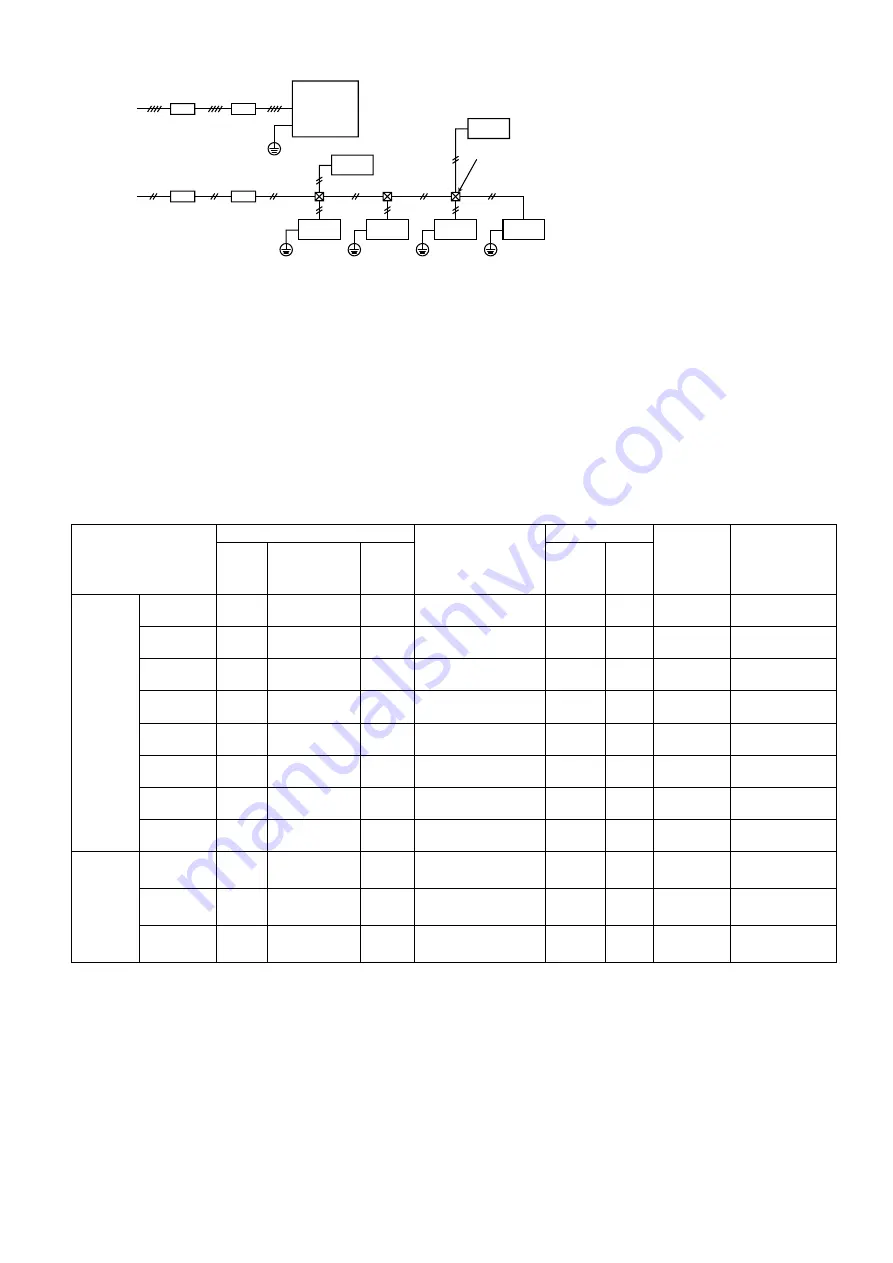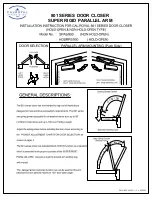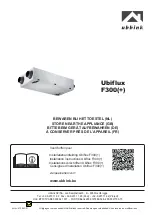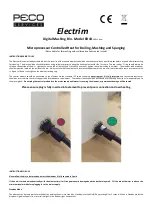
GB-42
WT08432X01
・
Wiring example
Ⓑ
Ⓐ
Ⓑ
Ⓐ
Ⓓ
Ⓔ
Ⓔ
Ⓔ
Ⓔ
Ⓒ
Ⓕ
Ⓖ
Ⓗ
Ⓕ
Ⓕ
Ⓕ
Ⓕ
Ⓐ
Earth leakage breaker
Ⓑ
Local switch (Overcurrent breaker and earth
leakage breaker)
Ⓒ
Outdoor unit
Ⓓ
Pull box
Ⓔ
Indoor unit
Ⓕ
Earth
Ⓖ
Main BC controller
Ⓗ
In an R2 system: Sub BC controller
In a Hybrid City Multi system: Sub-HBC
・
Be sure to use the appropriate type of overcurrent breaker. Note that generated overcurrent may include some
amount of direct current.
・
Select the type of breaker for an inverter circuit as an earth leakage breaker. (Mitsubishi Electric NV-S series or its
equivalent)
・
The earth leakage breaker should be used in combination with a local switch.
・
Use a local switch with at least 3 mm (1/8 in) contact separation in each pole.
・
Do not connect the power cables L1, L2, and L3 to N. Ensure the correct phase sequence.
・
If the power cable is damaged, it must be replaced by the manufacturer, its service agent or similarly qualified
persons in order to avoid a hazard.
・
Use dedicated power cables for the outdoor unit and indoor unit. Ensure OC and OS are wired individually.
・
Power cable size, device capacity, and system impedance
(If local regulations do not specify the minimum power cable size or device capacity, follow the values in the table
below.)
Minimum size [mm
2
(AWG)]
Earth leakage breaker
Local switch (A)
Overcurrent
breaker
(NFB) (A)
Maximum
allowable system
impedance
Power
cable
Power cable
after branching
point
Earth
wire
Capacity
Fuse
Outdoor
unit
(E)P200
4.0 (12)
–
4.0 (12)
30 A 100 mA 0.1 sec.
or less
25
25
30
*
3
(E)P250
4.0 (12)
–
4.0 (12)
30 A 100 mA 0.1 sec.
or less
32
32
30
*
3
(E)P300
4.0 (12)
–
4.0 (12)
30 A 100 mA 0.1 sec.
or less
32
32
30
*
3
(E)P350
6.0 (10)
–
6.0 (10)
40 A 100 mA 0.1 sec.
or less
40
40
40
ȍ
(E)P400
10.0 (8)
–
10.0 (8)
60 A 100 mA 0.1 sec.
or less
63
63
60
ȍ
(E)P450
10.0 (8)
–
10.0 (8)
60 A 100 mA 0.1 sec.
or less
63
63
60
ȍ
(E)P500
10.0 (8)
–
10.0 (8)
60 A 100 mA 0.1 sec.
or less
63
63
60
ȍ
(E)P550
10.0 (8)
–
10.0 (8)
60 A 100 mA 0.1 sec.
or less
63
63
60
ȍ
Total
operating
current of
the indoor
units
)$
1
1.5 (16)
1.5 (16)
1.5 (16)
20 A current sensitivity
*
2
16
16
20
(IEC 61000-3-3)
)$
1
2.5 (14)
2.5 (14)
2.5 (14)
30 A current sensitivity
*
2
25
25
30
(IEC 61000-3-3)
)$
1
4.0 (12)
4.0 (12)
4.0 (12)
40 A current sensitivity
*
2
32
32
40
(IEC 61000-3-3)
*1 Use the larger value of F1 or F2 as the value of F0.
F1 = Total of each indoor unit's maximum current × 1.2
F2 = {V1 × (Quantity of Type 1)/C} + {V1 × (Quantity of Type 2)/C} + {V1 × (Quantity of Type 3)/C} + {V1 × (Quantity of Type 4)/C}
*2 Current sensitivity is calculated using the following formula.
G1 = (V2 × Quantity of Type 1) + (V2 × Quantity of Type 2) + (V2 × Quantity of Type 3) + (V2 × Quantity of Type 4) +
(V3 × Power cable length (km))
*3 Meets technical requirements of IEC 61000-3-3.
~220–240 V
L, N
3N~380–415 V
L1, L2, L3, N
Summary of Contents for City Multi R2 Series
Page 2: ......
Page 62: ...GB 60 WT08432X01 ...
















































